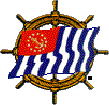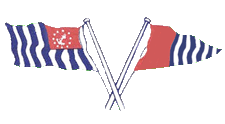 |
|
|
|---|---|---|
Flag and Etiquette
|
Do It Right! |
|
|
|
||
Single Flag Signal Codes

When displayed individually, signal flags have a special meaning as shown below.
The last example, the distress signal, shows a
case where a pair of flags
is used.
K. Scott Hunziker has developed a simulator to practice reading signals

A - Diver below (when stationary); Keep Clear; See Divers Flags

B - Dangerous Cargo

C - Yes (affirmative)

D - Keep Clear

E - I am Altering my Course to Starboard

F - I am Disabled

G - I Require a Pilot

H - I have a Pilot on Board

I - I am Altering my Course to Port

J - On Fire; Keep Clear

K - I Desire to Communicate

L - You Should Stop Instantly

M - I am Stopped
Not international but commonly used: Doctor on board

N - No (Negative)

O - Man Overboard

P - the Blue Peter - About to Sail

Q - I Request Pratique
R -

S - My Engines are Going Astern

T - Keep Clear of Me
Not international but commonly used: Request for transportation (from club launch)

U - You are Standing into Danger

V - I Require Assistance

W - I Require Medical Assistance

X - Stop Your Intention

Y - I am Dragging Anchor

Z - I Require a Tug
Answering Pennant

Code and answering pennant.
The answering pennant is used as a decimal point when sending numeric data. Close up (top of mast), the receiving vessel indicates she understands the hoist. At the end of the signal it indicates that the message is complete. At dip (half masted), hoisted by the receiving vessel as each hoist of the transmitting ship is seen.
Distress
 
|
N + C - I am in distress

|
|
